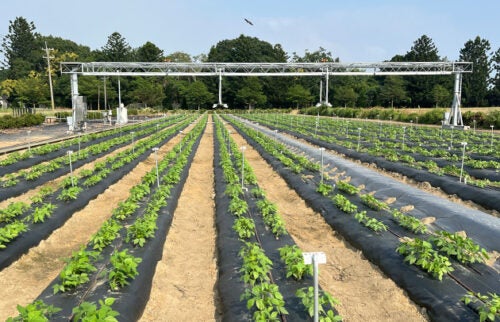
The humble mung bean has a new trick up its sleeve: besting climate change
Key facts:
The humble mung bean has sustained civilizations for more than 4,500 years during its cultivation across Asia.
USC Dornsife researchers discovered a distinct cultivation path, revealing influential factors in the crop’s expansion.
Two distinct variants of mung bean were identified: One thrives in short growing seasons and extreme heat while the other exhibits drought tolerance.
These findings offer crop breeders — and the millions of people who rely on this food supply — a future in the face of climate change projections.
The mung bean, commonly known as green gram, has played a pivotal role as a cheap protein source in regions where access to meat is limited. Spanning 4,500 years, the cultivation of this humble legume has sustained civilizations throughout history.
While its migration routes and cultivation expansion have been a mystery, a new study by researchers at the USC Dornsife College of Letters, Arts and Sciences that was published in eLife reveals insights into the circuitous odyssey of this resilient crop.
The study, co-led by Sergey Nuzhdin, professor of biological sciences at USC Dornsife, employed cutting-edge genomic techniques to trace the evolutionary trajectory of the mung bean. The team analyzed mung bean seeds from three global seed banks, including the Australian Diversity Panel, the World Vegetable Center in Taiwan and the Vavilov Institute of Plant Industry in Russia.
The research unveiled a distinctive path of cultivation and shed light on the factors influencing its expansion.
Contrary to previous assumptions — based on the geographical proximity between South and Central Asia — genetic evidence suggests that the mung bean first spread from South Asia to Southeast Asia, and then finally reached Central Asia, including Western China, Mongolia, Afghanistan, Iran and Russia.
Adapting to climate
Nuzhdin and his team of international scientists used an interdisciplinary approach that looked at population information, environmental conditions, empirical field and laboratory investigation, and historical records from ancient Chinese sources. Through this analysis, they discovered that divergent climatic conditions and farming practices across Asia shaped the mung bean’s unique trajectory, not deliberate human cultivation choices.

Nuzhdin was surprised that the evolution was not solely driven by human activity through domestication but instead was intricately intertwined with the mung bean’s adaptation to diverse climates encountered throughout its journey.
What the research unraveled was the existence of two distinct adaptations of the mung bean, each favored in specific geographic locations.
The southern variant, originating in South Asia before 1077 CE, is characterized by larger seeds, favoring higher yields in regions with scorching climates.
In contrast, the northern variant, originating in northern China around 544 CE, exhibited drought tolerance and a short vegetative period during the summer planting season.
The mung bean later spread to the rest of China and Southeast Asia including Cambodia, Indonesia, the Philippines, Thailand, Vietnam and Taiwan.
Genetic variations
While the study’s historical revelations are compelling in their own right, their implications have relevance to new ways of breeding crops. The mung bean’s genetic makeup, including its short growing season and resilience to extreme heat, hold significant potential for mitigating the impact of climate change on agriculture. Particularly in Southeast Asia, where prolonged heat waves and the severity and impact of flooding threaten valuable agricultural areas, these genetic variants could prove to be a game-changer in the face of climate change.
“Our findings offer a critical roadmap for breeders aiming to enhance mung bean production in the face of climate change predictions, especially in the southern regions. This fundamental research holds immense importance in guiding the selection of genetic materials for breeding programs,” Nuzhdin said.
About the study:
The USC components for the study, “Environment as a limiting factor of the historical global spread of mung bean,” were funded by the United States Agency for International Development and the Zumberge Foundation. Funding was also provided by the Ministry of Science and Technology, Taiwan; the Australian Center for International Agricultural Research; the strategic long-term donors to the World Vegetable Center; The Republic of China (Taiwan); the UK government; Germany; Thailand; Philippines; Korea; and Japan. The Russian Scientific Fund Project and the Ministry of Science and Higher Education of the Russian Federation also contributed.